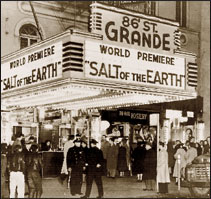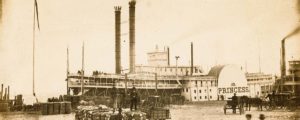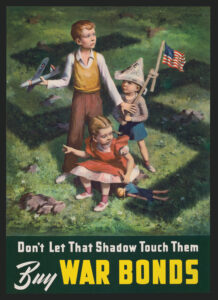 Library of Congress |
| The film premiered on March 14, 1954, at the only theater in New York City that would show it. |
When director Elia Kazan’s On the Waterfront opened in 1954, critics and audiences hailed the gritty movie about Hoboken dockworkers and applauded Marlon Brando’s performance as the ex-boxer who ‘coulda been a contender.’ At the next Academy Awards ceremony, On the Waterfront won Oscars for best film, best director, best actor, and best supporting actress.
Another movie about beleaguered workers opened to quite a different reception that same year. Like Kazan’s film, Salt of the Earth was based on an actual situation, in this case a mining strike in New Mexico. Both movies were shot on location with the participation of those who had lived the real stories. And both movies shared a history in the Hollywood blacklist. There the similarities ended. Kazan and his writer, Budd Schulberg, had both named names — identified movie people they said were Communists — when questioned by the House Un-American Activities Committee (HUAC). Some saw their movie, in which Brando’s character testifies against the racketeers who run the docks, as an allegory in support of informing. The people behind Salt, in contrast, were unrepentant blacklistees whose leftist political affiliations derailed their careers during the Red scares of the 1950s. On the Waterfront was a hit and is remembered as a classic film. The makers of Salt of the Earth struggled to find theater owners willing to show their incendiary movie.
It required a great deal of optimism to make a left-leaning movie like Salt of the Earth in the early 1950s, but director Herbert Biberman was, by many accounts, a great optimist. The director of now-forgotten films such as Meet Nero Wolfe and The Master Race, Biberman had helped found the Screen Directors Guild, which later became the Directors Guild of America. He was also a Communist and one of many movie professionals who found inspiration in the Soviet Union — or at least what dictator Joseph Stalin allowed the world to see of the Soviet Union. Throughout the 1930s, the Communist Party USA remained active in Hollywood, establishing guilds to give writers and actors bargaining clout against the studios, and fighting against Fascism abroad by championing the Spanish Republic and rallying against the Third Reich. Stalin’s pact with Adolf Hitler in 1939 disillusioned many a Beverly Hills Bolshevik, though some, like Biberman, remained unswayed.
When the United States entered World War II in 1941, the Soviet Union became an ally, and Hollywood began to make movies that celebrated our newfound comrades. Those films returned to haunt the movie industry when World War II ended and the Cold War pitted the United States against the Soviet Union. Suddenly the U.S. government began casting a critical eye on the movie industry, and HUAC began investigating Communist influences on the silver screen.
HUAC’s most visible targets were the so-called Hollywood Ten, filmmakers the committee charged with contempt of Congress in 1947 after they refused to answer questions about Communist affiliations. In 1950 the Supreme Court declined to consider the filmmakers’ appeals, and the Hollywood Ten began serving their sentences. Herbert Biberman, 50, served six months at a federal institution at Texarkana, Texas. Incarcerated with him was another of the Ten, writer Alvah Bessie. Compared to the ebullient Biberman, Bessie was a dour cynic. He cringed at Biberman’s incessant good manners and his penchant for preaching politics to guards and prisoners, but he did have to admire Biberman’s dedication to his beliefs, especially when he learned that the director had offered to serve six extra months to get Bessie released earlier.
In 1951, HUAC increased the pressure on the movie industry with a new batch of subpoenas for Communist Party USA members, past members, and even non-affiliated liberals. The studios fell in line and expanded their unofficial blacklist. Actors, producers, directors, and other industry professionals whom the studios deemed tainted by leftist beliefs suddenly found themselves unemployable. Biberman, fellow Ten member and producer Adrian Scott, theater owner Simon Lazarus, and blacklisted screenwriter Paul Jarrico saw possibilities for that discarded talent. They teamed up to form Independent Productions Corporation and set out to find a story to tell.
Jarrico found the subject matter while on a family vacation in New Mexico, where he heard about a mining strike in Grant County. The strikers were predominantly Mexican Americans, members of the Union of Mine, Mill, and Smelter Workers, a union the Congress of Industrialized Organizations (CIO) ejected in 1949 for alleged Communist influences. The strikers demanded that the Empire Zinc Corporation give them the same benefits and wages it gave the region’s Anglo miners. ‘The central issue, really, was dignity, equality, being treated like anybody else,’ remembers Clinton Jencks, a decorated World War II veteran the union sent to help out Local 890. He found that company housing for Mexican Americans lacked indoor plumbing and that the company organization was stacked in favor of Anglo workers. ‘They had separate change rooms, separate payrolls, separate places to eat your lunch, strict locks on promotions with all the better jobs reserved for Anglos,’ Jencks says. ‘We eventually broke all that down, but it was very consciously being used as a way to keep people fighting each other instead of the company.’
The strike nearly collapsed after eight months when Empire Zinc opened the mine to scab labor and obtained a court injunction prohibiting union pickets on company property. Then the wives and mothers of the union’s Ladies’ Auxiliary circumvented the injunction by marching in place of the men.
Jarrico was invigorated by what he had seen. The filmmakers had found their story. Biberman would direct and Jarrico would take on the role of producer, as Adrian Scott dropped out due to illness. Jarrico asked his brother-in-law and fellow blacklistee, Michael Wilson, to write the screenplay. Wilson traveled to Grant County and attended union meetings, visited the miners’ homes, and watched and listened as the strike unfolded.
It was a violent time. ‘The company would hire guys who were out-and-out gunmen and send them over to the sheriff and the sheriff would deputize them,’ says Jencks. At one point the sheriff locked up 45 women and 17 children, an action that appalled New Mexico’s governor. In late summer, strikers descended upon three carloads of strikebreakers nearing the company entrance. The scabs attempted to push their cars past the picketers and knocked down three women. A strikebreaker shot into the crowd, wounding a picketer in the leg. News of the confrontation flashed through the mining district. Nearby mines emptied as their workers went to bolster the picket line.
The strike was settled on January 21, 1952. The company agreed to higher wages and insurance benefits but denied the union’s demand for paid holidays and remuneration for all time spent underground. Although it wasn’t part of the settlement, the company soon provided hot running water for the miners’ homes.
For Wilson, the strike provided an opportunity to tell a story that wove together the struggles of Mexican Americans, labor, and women. He saw the dramatic potential to examine how the mineworkers reacted when their wives took over the picket lines and they had to sit on the sidelines. And he wanted to tell the story from the participants’ point of view and use their feedback to fine-tune his screenplay. So when he finished his script treatment, Wilson took it to Grant County. People there objected to one scene where the main character had an extramarital fling and another in which he purchased whiskey with his last paycheck. Wilson cut the scenes. They were perfectly acceptable as drama, he explained to his partners, ‘But we’re dealing with something else. Not just people. A people.’ As Wilson labored to complete a final script over the next year, he had union members and their wives look over all his drafts.
In the meantime, Simon Lazarus began the process of assembling a crew. When he approached Roy Brewer, head of the International Alliance of Theatrical and Stage Employees Union (IATSE), Brewer, not surprisingly, refused to cooperate. ‘There has been a real Communist plot to capture our unions in Hollywood,’ he had told HUAC in 1947. Furthermore, Brewer warned Lazarus that further association with the blacklistees would finish the theater owner’s career.
Producer Paul Jarrico, a diehard Communist whose optimism may have even surpassed Biberman’s, remained undeterred. He was not someone who would back down from a fight, as Howard Hughes, who owned the RKO studio, learned when he removed Jarrico’s writing credit from The Las Vegas Story. Jarrico sued him but lost. (He finally received the credit, posthumously, in 1998.) So despite Brewer’s stand, Jarrico began scouring the country for craft people willing to ignore industry edicts. Some were blacklistees, others were documentary filmmakers who wanted to break into features, or greenhorns eager for experience.
Finding a cast would be equally difficult. Anglo actors such as Will Geer and David Wolfe, both blacklisted, signed on as the sheriff and the chief foreman, respectively. The lead roles proved more difficult to fill. The filmmakers first cast a blacklisted white actor for the role of the striking miner, Ramon, and picked Biberman’s wife, blacklisted actress Gale Sondergaard, as Ramon’s wife, Esperenza. Realizing the hypocrisy of this casting, they started looking for Mexican-American actors, with no luck. In Mexico, the company found award-winning actress Rosaura Revueltas, whose young career included only a few films. They signed her to play Esperenza. But when the production arrived in Silver City, New Mexico, in January 1953, it still lacked a male lead.
Clinton Jencks remembers the community’s initial response to the Hollywood attention. ‘They found it hard to believe that their lives were interesting enough to make a movie,’ says Jencks. ‘I think we romanticized the Hollywood people, and the Hollywood people romanticized us.’ Some locals pitched in to help build a mine façade on the ranch of Alford Roos, an elderly independent mine owner, archeologist, explorer, writer, and rifle-toting Mohammedan with Jeffersonian political leanings. Roos rented his land to the filmmakers for one dollar. Many other locals found roles in front of the camera. Biberman hired the Roderick brothers, two lanky white miners from another union, to play redneck deputies. Local 890 vice-president Ernesto Velasquez portrayed a union official. Jencks played the Anglo representative from the union’s headquarters, his real-life role, and his activist wife, Virginia, played her counterpart on screen. The production cast other members of Local 890 as miners and their wives.
Juan Chacon was the union’s newly elected president, and both Revueltas and Biberman’s sister-in-law, Sonja Dahl Biberman, suggested that the director consider him to play Ramon. The director thought that ‘Johnny’ Chacon was too gentle, too small, and too shy for the part, but he let him audition. Chacon gave an unimpressive reading, but the women insisted he had potential. With only three weeks left until shooting, the exasperated director finally decided to take a chance and cast Chacon as Ramon.
Throughout the shooting, Biberman marveled as Chacon grew into the part of Ramon. ‘We found we didn’t have to ‘act’,’ Chacon would later write about the experience. ‘El Biberman, as we came to call him, was happiest when we were just ourselves.’ In the first scene Biberman shot with dialogue, Jencks’ character restrains Ramon from attacking the foreman. The material touched sensitive nerves, and Biberman let the tension build. Afterwards, if Biberman still doubted that Chacon could get into character, Jencks had the bruises to prove he could.
At the end of January, the miners and their wives flocked to Silver City’s theater to watch the first ‘rushes,’ and they laughed and applauded at their images on the big screen. Yet even as the movie progressed, storm clouds were forming. A Silver City schoolteacher wrote to Walter Pidgeon, president of the Screen Actors Guild, and expressed concern that a Communist film company was manipulating the local Mexican Americans. Soon the media and the government began scrutinizing the maverick movie troupe. Columnist Victor Riesel pointed out the production’s proximity to the Los Alamos atomic research facility. Congressman Donald Jackson said the film was ‘deliberately designed to inflame racial hatreds and to depict the United States of America as the enemy of all colored peoples.’ It was, he said, ‘a new weapon for Russia.’
The critical reaction created problems. Pathé Laboratories suddenly refused to process the daily rushes, so Biberman could no longer review each day’s work and had to print scenes blind. Immigration officials came for Revueltas — they had sudden concerns about her passport — and deported her back to Mexico. Biberman had to use a stand-in for some sequences, but he still needed the actress for voice-overs and frontal shots. Eventually, Revueltas recorded narration under clandestine circumstances in a dismantled Mexican sound studio, and the crew shot final footage of her in Mexico and then smuggled it like contraband over the border.
‘It’s Time To Choose Sides,’ read a headline in the Silver City Daily Press. Late one night in early March, someone fired shots into Clint Jencks’ parked car. The next day two carloads of troublemakers broke up the filming in front of the union hall. Jencks emerged from the fracas with a black eye, and the violent crowd nearly destroyed the camera. That night the vigilantes selected 10 emissaries to relay an ultimatum to the movie people: If they did not leave by noon the next day they would leave in black boxes. The sheriff was forced to call in the state police, who kept the peace as the crew finished the final scenes. Several weeks later someone burned the home of one of the film’s Anglo miners.
The film was still far from completed. Now the laborious job of post-production — the assembly and polishing of the film — began, and the movie industry made the process more difficult by throwing up as many roadblocks as it could. As Howard Hughes explained in a letter to Congressman Donald Jackson, the studios could effectively kill the picture if they denied the production access to the facilities they needed — to edit, dub, score, and otherwise prepare the movie for theaters.
Biberman and Jarrico refused to quit. They found a company willing to process the film after several labs refused, and they recruited an editor and installed him in a house in Topanga Canyon, north of Los Angeles. The editor, who had worked only on documentaries, proved unsuitable. Worse, the tin-roofed editing quarters became so hot the film began to shrivel. As the filmmakers scrambled to find another editor, they moved operations into the ladies room of an empty theater that Simon Lazarus owned in Pasadena. After firemen came snooping they relocated again, this time to a vacant studio in Burbank. By the time it was finished the film used four editors, one of whom was an FBI informer.
By the beginning of 1954, the moviemakers had turned their raw footage into a movie. The next hurdle would be finding theaters to show it. Roy Brewer, the anti-Communist head of the IATSE, represented projectionists, and he was hardly likely to steer Salt on to movie screens. As he wrote to Congressman Jackson, ‘The Hollywood AFL Council assures you that everything which it can do to prevent the showing of The Salt of the Earth will be done.’ In New York City the production found a theater owner whose projectionists belonged to a different union. After much persuasion he agreed to host the film’s opening. Salt of the Earth premiered at the Grande Theater on March 14, 1954, to mostly positive reviews. The New York Times‘ Bosley Crowther wrote that ‘an unusual company made up largely of actual miners and their families plays the drama exceedingly well.’ While several found it unfairly pro-labor, few saw it pro-Red, save a young writer named Pauline Kael, who wrote that it was ‘as clear a piece of Communist propaganda as we have had in many years.’
Communist or not, lines such as ‘This installment plan, it’s the curse of the working man,’ indicate the shortcomings of writing for ‘a people’ instead of people. In his account of the blacklist era, writer Stefan Kanfer referred to Wilson’s ‘clanking, agitprop prose.’ In some scenes the shortcomings of an inexperienced crew and amateur cast are obvious. Elia Kazan may have named names, but with On the Waterfront he also made the superior picture. Salt ran at the Grande for nine weeks, taking in a more-than-respectable $50,000, and opened in another dozen or so American theaters. The film was warmly received overseas, especially in France, and it won the grand prize from the Paris Academy of Film. Salt also triumphed at its premiere in Mexico City, where audiences considered Rosaura Revueltas a star. In 1956 the film company filed an anti-trust suit charging more than 100 industry figures with conspiracy. That done, Biberman and Jarrico resigned from the company to move on to other work. After eight years of litigation, they lost their suit.
Today the movie is largely forgotten, but the passions and upheaval behind its creation have refused to completely die away. When the Academy of Motion Picture Arts and Sciences announced it would give director Elia Kazan a lifetime achievement award at the 1999 Academy Award ceremonies, it reopened wounds that had not yet healed. In the end, Kazan received his award without incident.
Many of the people blacklisted never found work in movies again. Some writers found employment by working under pseudonyms or having acceptable writers ‘front’ for them. Michael Wilson won Oscar attention for his scripts, even though his name did not appear on the final films. In later, friendlier years he would get credit for writing Friendly Persuasion and for his contributions to The Bridge on the River Kwai and Lawrence of Arabia.
Biberman developed land in Los Angeles and wrote a book, Salt of the Earth: The Story of a Film, published in 1965. He directed one more movie, Slaves, a poorly received variation on Uncle Tom’s Cabin. He died of bone cancer in 1971.
Jarrico wrote scripts in Europe and returned to the United States in the late 60s, his Communist years long behind him. ‘I’m probably the only writer who has been blacklisted on both sides of the Iron Curtain,’ he said. He found television work and wrote films such as The Day That Shook the World. He also fought to get blacklisted writers the screen credits denied them. He died in 1997 in an automobile accident near Ojai, California, at the age of 82. The day before he had received honors at a star-studded Beverly Hills soiree entitled ‘Hollywood Remembers The Blacklist.’
This article was written by Steve Boisson and originally published in the February 2002 issue of American History Magazine. For more great articles, subscribe to American History magazine today!




